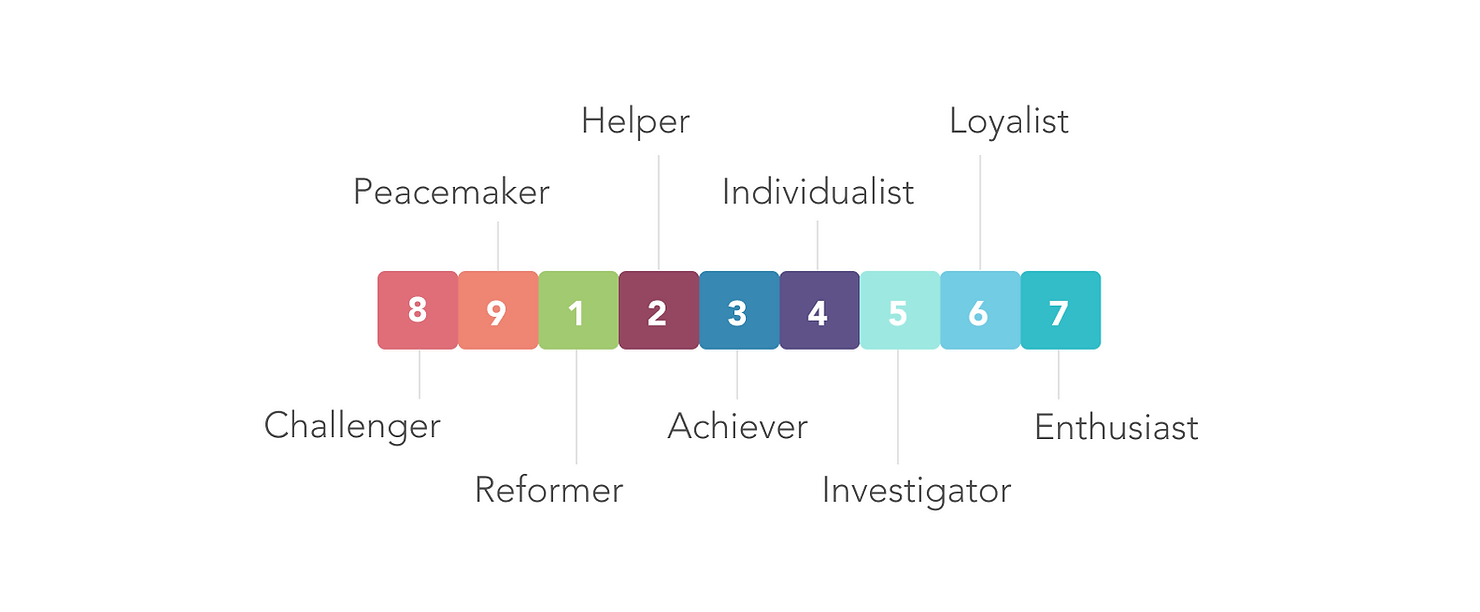
The nine Enneagram types are uniquely different, but some of them are interrelated in deep and meaningful ways. “Triads” are the mechanism that Enneagram scholars use to group certain Enneagram types together and highlight their important commonalities.
There are four triads: Center, Social, Coping, and Harmony. The Center triad groups Enneagram types based on the most influential part of their psyche (thinking, feeling, instinct). The Social triad groups types based on how they get their needs met in social situations (demanding, withdrawing, complying). The Coping triad groups types based on how they respond to conflict and pain (positive thinking, competency, reactive). The Harmony triad (also known as “Dominant Affect Groups”) groups types based on how they interact with the world (idealist, relationist, pragmatist).
Center triad
We can think of the human psyche as a culmination of three “centers:” gut instincts, feelings, and thoughts. All of us regularly tap into each of the three centers to function, but there is one center with which each Enneagram type is out of balance, either because they over-rely on it, under-express it, or suppress it entirely. The “Center triad” to which each type belongs signals the center that the type must work diligently to bring into balance.
The Instinctive types are Ones, Eights, and Nines, all of whom are attuned to creating and maintaining a sense of autonomy. They want to engage actively with the world without being imposed upon. Underneath the surface, they tend to harbor a significant amount of rage.
The Feeling types are Twos, Threes, and Fours, all of whom are attuned to developing their identities, figuring out who they are and the value they provide to the world. Underneath the surface, they tend to harbor a significant amount of shame.
The Thinking types are Fives, Sixes, and Sevens. These types are in search of a sturdy inner sense of knowing and guidance, a feeling of certainty about how the world works and how to best function within it. Underneath the surface, they tend to harbor a significant amount of fear.
Social triad
The “Social triad” (also known as “Hornevian Groups”) describes the social style of each Enneagram type—how they try to get their needs met in social situations. Each type pursues one of three social strategies in order to feel fulfilled: comply, demand, or withdraw.
The Compliant types are Ones, Twos, and Sixes. These types comply with their superego, their morals and values, to figure out how to do right by others in social situations. These types are socially considerate, but tend to possess a subtle sense of superiority.
The Demanding types are Threes, Sevens, and Eights, all of whom take an active and direct approach to getting their needs met in social situations. These types are socially assertive, but tend to have difficulty processing their feelings.
The Withdrawn types are Fours, Fives, and Nines. These types tend to withdraw from the world and others in social situations to get their needs met, retreating into their imaginations where they are more at ease. These types are socially observant, but tend to feel alienated from their surroundings.
Coping triad
The “Coping triad” (also known as “Harmonic Groups”) describes how each Enneagram type behaves in the face of loss, disappointment, or failure—that is, how they react when they don’t get what they want.
The Competency types are Ones, Threes, and Fives. These types try to remain detached and unemotional in difficult situations so they can tap into their internal framework of logic, a system of rules and procedures, to determine the best course of action. Although all of the personality types use mental models to navigate life, the Competency triad over-relies on them under distress.
The Positive Thinking types are Twos, Sevens, and Nines. These types deal with difficult situations by adopting a positive attitude and finding ways to reframe them in a positive light. Anything that could be construed negatively has an alternate, positive explanation. If there’s a bright side, these types will find it. It is important to them to believe that everything will work out, because underneath their positive attitude is a fear that an issue will arise that forces them to face negative aspects of themselves.
The Reactive types are Fours, Sixes, and Eights. These types react strongly and vocally in difficult situations as a coping strategy to deal with their negative emotions. If these types have a problem, other people will undoubtedly hear about it. They want to express themselves fully when they are in conflict or upset and expect others to acknowledge the magnitude of their emotional states. It is important to them to know where others stand in conflict, because underneath their reactivity is a fear of being betrayed and abandoned.
Harmony triad
For a person to be in harmony, they must be connected to their thinking, feelings, and instincts. The “Harmony triad” (also known as “Dominant Affect Groups”) describes how each Enneagram type can move from one singular way of perceiving the world to a rich, comprehensive experience of reality. By integrating the profound wisdom of their head, heart, and body, each type can become more balanced and whole, equipped with everything they need to understand themselves, connect with others, and live a content life.
The Idealist types are Ones, Fours, and Sevens. These types hold a vision of how the world could be and become frustrated when reality doesn’t meet their hopes, dreams, and expectations. They strive to manifest their ideals, and ward off disappointment by focusing on potential and possibilities. Idealist types become more in alignment when they’re able to release their fear of disappointment, appreciate the world as it is, and embrace the good and beauty that already surrounds them.
When a One, Four, or Seven is out of balance with their center, they take on the negative characteristics of the other Idealist types. For example, when a Seven (thinking center) over-relies on their thinking, they:
become out of balance with their heart (feelings) and experience the dark, painful emotions of the Four
become out of balance with their body (instincts) and take on the antagonism and judgment of the One
By relying on all three centers equally, Sevens are able to be more whole and take on the positive characteristics of all the Idealist types. Sevens:
become more creative in their vision when they lean into their heart (feelings) like the Four
become more grounded in reality and logical when they lean into their body (instincts) like the One
The Relationist types are Twos, Fives, and Eights. These types embody an important function as a way of relating to the world while evading rejection. They strive to establish power by mastering a role that acts as a form of self-protection. By minimizing their own needs and vulnerabilities and leading with what they can provide to others, they are able to more easily connect without risking rejection. Relationist types become more in alignment when they’re able to release their fear of rejection and let love, energy, and relationships flow naturally.
When a Two, Five, or Eight is out of balance with their center, they take on the negative characteristics of the other Relationist types. For example, when a Two (feeling center) over-expresses their feelings, they:
become out of balance in their mind (thinking) and are hyper-analytical and conspiratorial like the Five
become out of balance with their body (instincts) and are demanding and enraged like the Eight
By relying on all three centers equally, Twos are able to be more whole and take on the positive characteristics of all the Relationist types. Twos:
become more clear-thinking and rational when they lean into their mind (thinking) like the Five
become more decisive and confident when they lean into their body (instincts) like the Eight
The Pragmatist types are Threes, Sixes, and Nines. These types are able to see the world realistically and avoid feeling lost by figuring out how they fit into it, attaching themselves to reassuring people and systems. They strive to find a well-identified place in the world, leaning into their natural skills to find a sense of belonging. Pragmatist types become more in alignment when they’re able to release their fear of loss, and immerse themselves in the richness of the world without seeing themselves in reference to others.
When a Three, Six, or Nine is out of balance with their center, they take on the negative characteristics of the other Pragmatist types. For example, when a Nine (instinct center) suppresses their instincts, they:
become out of balance in their mind (thinking) and experience the indecision and angst of the Six
become out of balance with their heart (feelings) and are uncertain of what they want and seek external validation like the Three
By relying on all three centers equally, Nines are able to be more whole and take on the positive characteristics of all the Pragmatist types. Nines:
become more forward-thinking and diligent when they lean into their mind (thinking) like the Six
become more charming and ambitious when they lean into their heart (feelings) like the Three
Triads in practice
Sometimes you’ll notice uncanny similarities between people of different Enneagram types. When this happens, check to see if those people share a triad. You may notice your mom and brother (a Seven and a Two, respectively) encourage you to look on the bright side and assure you that you’ll do great when you confide in them about a bleak situation. Both of them happen to be in the Positive Thinking triad (within the Coping triad).
Alternatively, you may notice two of your friends are proactive socializers, expecting to become an important part of the action the second they walk into a room. Even though they’re different types (a Three and an Eight), both friends are members of the Demanding triad (within the Social triad), which explains their similar social approaches. Triads add an extra layer of depth to predicting people’s thoughts and actions, and as an Enneagram scholar, make you better equipped to treat others how they want to be treated.


